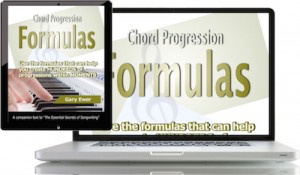Back in the early 70s the band Chicago recorded “Happy ‘Cause I’m Going Home” (Robert Lamm) for their second album. What I love about the chord choices is the primarily minor key feel at the beginning — F#m-Bm — in a song that’s supposed to be about being happy.
There’s a chorus-y section where the chord brighten considerably, giving all the impression that it’s going to move into the relative major key of A major. It then goes through a sequence of chords whose roots descend by semitones before moving back to F# minor.
 “Chord Progression Formulas” can give you lots of progressions to try in mere moments by using some standard easy-to-use formulas. If you like the chords-first songwriting process, you need this eBook. Get it separately, or as part of “The Essential Secrets of Songwriting 10-eBook Bundle”
“Chord Progression Formulas” can give you lots of progressions to try in mere moments by using some standard easy-to-use formulas. If you like the chords-first songwriting process, you need this eBook. Get it separately, or as part of “The Essential Secrets of Songwriting 10-eBook Bundle”
Minor keys don’t strike us as being obvious choices for music that’s supposed to be happy, but you’ll find that you’ll deepen the emotional experience for your listeners if you avoid stereotypical choices, like major for happy and minor for sad.
All of this is simply to say that chords matter when it comes to enhancing what listeners feel from your music. Here are some other ideas, all governed by chords, that can help steer your listeners’ emotional responses in the direction you want:
- Create progressions with descending bass lines to enhance the feeling of melancholy or introspection. If you want your audience to really pick up a sense of deep thought, bass lines that descend by step will often work. Play the following progression, 2 beats per chord, and you’ll see what I mean:
C G/B Am Am7/G F C/E Dm G - Create progressions with ascending bass lines to enhance the feeling of empowerment or positivity. My favourite example of this, which I’ve mentioned on this blog before, is the middle section of the theme from “The West Wing”, which gives us this:
Em D/F# Gsus4 G G/B C D C/E D/F#
The bass line starts on E and rises continuously from E to F#-G-B-C-D-E-F#. You can hear the emotional power that comes from that rising line. - Try implied chords in a verse progression or song intro. An implied chord simply means that some of the notes of a chord are present, but not full triads. You can try this in a song intro (“Rock Me Gently” – Andy Kim), or in the intro and first verse of “Only Girl (In the World)” (Crystal Johnson, Mikkel S. Eriksen, Tor Erik Hermansen, Sandy Wilhelm). There’s enough of the full chord floating around in the accompaniment, but not as full, strummed chords. That gives a nice, transparent effect, and helps for when chords become much fuller in the chorus.
- Choose a new key as your song moves from verse to chorus. It’s not uncommon to hear songs that move from a minor key to the relative major (for example, from A minor to C major). But I’m talking about trying a completely new chorus key that isn’t so closely related. You might try moving from a C major verse to an Eb major chorus by using this progression:
C F Dm G Em Am Bbsus4 Bb ||Eb Ab…
Or from a C major verse to a D major chorus this way:
C Am F G D/F# D G A7 ||D Bm…
Because the new key feels higher, it can give your music a psychological shot of emotional adrenaline that can be really useful in song choruses with uplifting, positive lyrics. - Try secondary dominant chords in songs that have an “anthem” feel. A secondary dominant requires a long explanation, but here’s a short version that will work for most songs in the pop genres: take a minor chord that’s followed by a chord whose root is 4 notes higher, like Dm-G. Now change that Dm to a major chord so that your progression is D-G. That brightening you get from the minor-to-major change gives you a strong feeling of inspiration. You’ll hear this in many anthem-like songs, like Paul Simon’s “Bridge Over Troubled Water”, at the lyric “And friends just can’t be found” (Eb7 Ab F Bb). The F, in the key of Eb major, is usually F minor. Because it’s followed by Bb (the chord 4 notes higher), it’s a prime candidate for changing it to major (F), creating a secondary dominant.
Just as Robert Lamm decided when he created the chords for “Happy ‘Cause I’m Going Home” that I mentioned at the start of this post, I encourage you to experiment with chords from an emotional point of view. Don’t just settle for typical choices. See what improvising and going in unexpected directions can do for your music.
 Written by Gary Ewer. Follow Gary on Twitter.
Written by Gary Ewer. Follow Gary on Twitter.
 “The Essential Secrets of Songwriting” 10- eBook bundle comes with a free copy of “Creative Chord Progressions” Learn how to move beyond I-IV-V-I progressions. It’s FREE when you buy “The Essential Secrets of Songwriting 10-eBook Bundle ($37 USD)
“The Essential Secrets of Songwriting” 10- eBook bundle comes with a free copy of “Creative Chord Progressions” Learn how to move beyond I-IV-V-I progressions. It’s FREE when you buy “The Essential Secrets of Songwriting 10-eBook Bundle ($37 USD)










